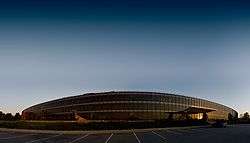IBM Research

IBM Research is IBM's research and development division. It is the largest industrial research organization in the world, with twelve labs on six continents.[1]
The roots of today's IBM Research began with the 1945 opening of the Watson Scientific Computing Laboratory at Columbia University.[2] This was the first IBM laboratory devoted to pure science and later expanded into additional IBM Research locations in Westchester County, New York starting in the 1950s,[3][4] including the Thomas J. Watson Research Center in 1961.[3][4]
IBM employees have garnered five Nobel Prizes, six Turing Awards, ten National Medals of Technology, and five National Medals of Science.[5]
As of 2014 the company held the record for most patents generated by a business for 22 consecutive years.[6]
Advances
Notable company inventions include the automated teller machine (ATM), the floppy disk, the hard disk drive, the magnetic stripe card, the relational database, the Universal Product Code (UPC), the financial swap, the Fortran programming language, SABRE airline reservation system, DRAM, copper wiring in semiconductors, the silicon-on-insulator (SOI) semiconductor manufacturing process, Watson artificial intelligence.[7]
Advances in nanotechnology include IBM in atoms, where a scanning tunneling microscope was used to arrange 35 individual xenon atoms on a substrate of chilled crystal of nickel to spell out the three letter company acronym. It was the first time atoms had been precisely positioned on a flat surface.[8]
Applications
Major undertakings at IBM Research have included the invention of innovative materials and structures, high-performance microprocessors and computers, analytical methods and tools, algorithms, software architectures, methods for managing, searching and deriving meaning from data and in turning IBM's advanced services methodologies into reusable assets.
IBM Research's numerous contributions to physical and computer sciences include the Scanning Tunneling Microscope and high temperature superconductivity, both of which were awarded the Nobel Prize. IBM Research was behind the inventions of the SABRE travel reservation system, the technology of laser eye surgery, magnetic storage, the relational database, UPC barcodes and Watson, the question-answering computing system that won a match against human champions on the Jeopardy! television quiz show. The Watson technology is now being commercialized as part of a project with healthcare company Anthem Inc..
IBM Research is home to 5 Nobel Laureates, 9 US National Medals of Technology, 5 US National Medals of Science, 6 Turing Awards, and 13 Inductees in the National Inventors Hall of Fame.
Notable IBM Research computer scientists
There are a number of computer scientists "who made IBM Research famous."[9] These include Frances E. Allen,[10] Marc Auslander, John Backus,[11][12][13][14][15][16] Charles H. Bennett (computer scientist), Erich Bloch,[17] Grady Booch, [18][19] [20] [21][22] Fred Brooks (known for his book The Mythical Man-Month),[23][24][25][26] Peter Brown,[27] Larry Carter,[28][29] Gregory Chaitin, John Cocke, Alan Cobham,[30] Edgar F. Codd, Don Coppersmith, Ronald Fagin, Horst Feistel, Jeanne Ferrante, Zvi Galil, Ralph E. Gomory, Jim Gray, Joseph Halpern, Kenneth E. Iverson, Frederick Jelinek, Reynold B. Johnson, Benoit Mandelbrot, Robert Mercer (businessman), C. Mohan, Michael O. Rabin, Arthur Samuel, Alfred Spector, Moshe Vardi, John Vlissides, Mark N. Wegman and Shmuel Winograd.
Other notable developments
- Data Encryption Standard (DES)
- Fast Fourier Transform (FFT)
- Benoît B. Mandelbrot's introduction of Fractals
- Magnetic disk storage (hard disks)
- One-transistor dynamic random-access memory (DRAM)
- Reduced Instruction Set Computer (RISC) architecture
- Relational databases
- Deep Blue, a grandmaster-level chess-playing computer
Laboratories
Research
- IBM Research – Africa
- IBM Research – Almaden
- IBM Research – Austin
- IBM Research – Australia
- IBM Research – Brazil
- IBM Research – China
- IBM Research – Haifa
- IBM Research – India
- IBM Research – Ireland
- IBM Research – Thomas J. Watson Research Center
- IBM Research – Tokyo
- IBM Research – Zurich
Historic research centers
- Cambridge Scientific Center
- IBM New York Scientific Center
- 330 North Wabash in Chicago
- IBM Laboratory Vienna[31]
Publications
References
- ↑ http://www.research.ibm.com/labs/
- ↑ "IBM Watson Laboratory at Columbia University". Columbia.edu. Retrieved 2010-05-05.
- 1 2 Beatty, Jack, (editor) Colussus: how the corporation changed America, New York : Random House, 2001. ISBN 978-0-7679-0352-3. Cf. chapter "Making the 'R' Yield 'D': The IBM Labs" by Robert Buderi.
- 1 2 IBM, "Watson Research Center: Watson Facility History"
- ↑ "Awards & Achievements". IBM. Retrieved 2012-05-23.
- ↑ "IBM Tops Patent List for 22nd Year as It Looks for Growth". Bloomberg. 2015-01-12.
- ↑ http://www.research.ibm.com/featured/history/
- ↑ Browne, Malcolm W. (April 5, 1990). "2 Researchers Spell 'I.B.M.,' Atom by Atom". New York Times. Archived from the original on 2009-08-03.
- ↑ "Computer scientists who made IBM Research famous", IBM, 17 December 2012, retrieved 16 January 2016
- ↑ Biography and oral history
- ↑ IBM Archives
- ↑ Stanford Archives
- ↑ NNDB profile
- ↑ Columbia University page
- ↑ New York Times obituary
- ↑ files/us-bbfinkel/john_backus_memorial.pdf John Backus Memorial
- ↑ IBM Archives
- ↑ Researcher personal page
- ↑ My developer Works blog
- ↑ Handbook of software architecture
- ↑ IEEE Software: On Architecture
- ↑ The Promise, The Limits, The Beauty of Software
- ↑ Master Planner: Fred Brooks Shows How to Design Anything
- ↑ NNDB profile
- ↑ Innovator: Fred Brooks
- ↑ The Grill: Fred Brooks (Computerworld)
- ↑ Business Insider (thumbnail)
- ↑ University of California, San Diego
- ↑ files/-/siam_short_course.pdf SIAM short course
- ↑ Recursivity (Blogspot)
- ↑ IBM Corporation. "Some key dates in IBM's operations in Europe, the Middle East, and Africa (EMEA)" (PDF). IBM History. Retrieved July 24, 2016.
Further reading
- Brennan, Jean Ford (1971). The IBM Watson Laboratory at Columbia University: A History. IBM.
External links
- IBM Research Official Website
- Projects
- Research History Highlights (Top Innovations)
- Research history by year
- Oral history interview with Martin Schwarzschild head of Watson Scientific Computation Laboratory at Columbia University, Charles Babbage Institute, University of Minnesota
- IBM Research's technical journals